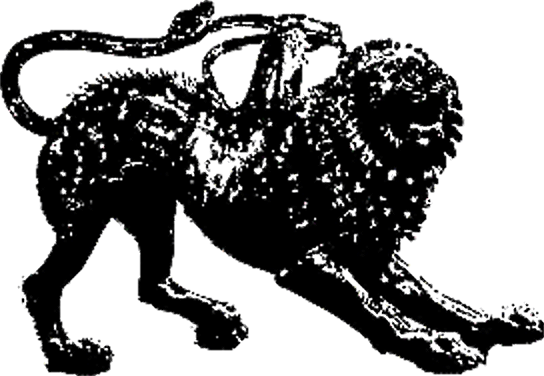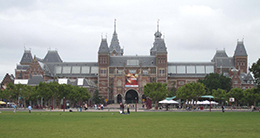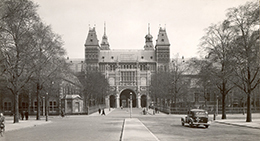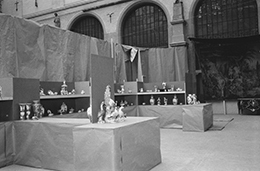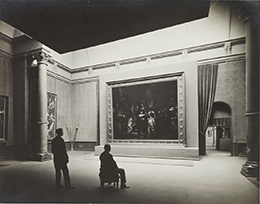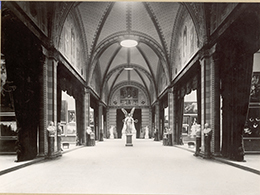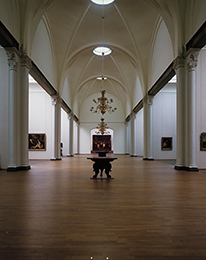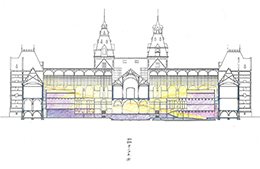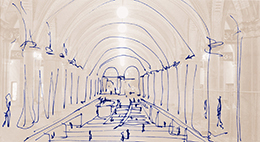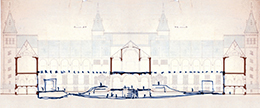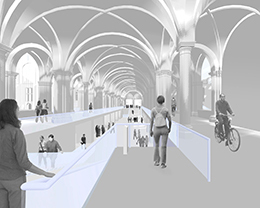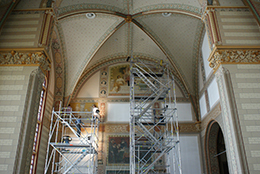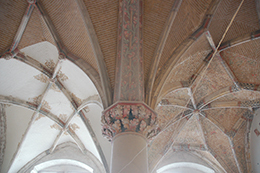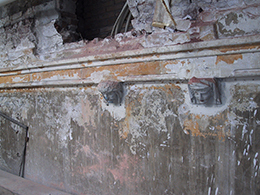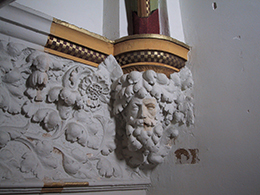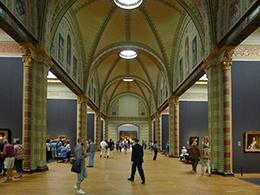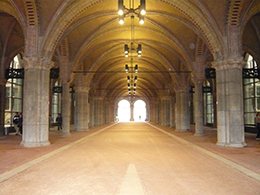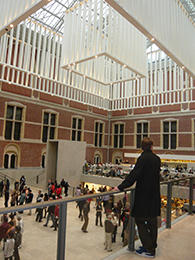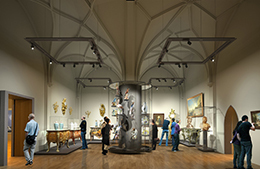No section
Paul Meurs und Marie-Thérèse van Thoor (Delft)
The transformation of the Rijksmuseum Amsterdam
urn:nbn:de:0009-21-42544
Transformations since the Opening
In the ninety years since its opening the interior of the Rijksmuseum had undergone numerous major and minor renovations, prompted by lack of space, growing visitor numbers and changing ideas about museum design. [1] The exterior for its part had remained almost unchanged since the museum was first built. Cuypers’ idea of the museum was a gathering place for art objects. Therefore he did not include storage space in his design for the building. The entire art collection was on display. Soon after the opening, with the collection growing, extra storage spaces and exhibition areas were created with false ceilings and partitions in the galleries, and even in the courtyards (fig. 3). In 1898 Alfred Lichtwark, director of the Hamburger Kunsthalle, called the museum “ein furchtbarer Zustand von Durcheinander”. [2]
At the start of the twentieth century criticism on this way of presentation increased, in the Netherlands as well as abroad. Several foreign museums, like in Berlin, Hamburg and Boston started to change their presentations, focusing less on presenting the entire collection, and more on the aesthetic feeling and presentation. The overabundant decorations of the Cuypers interior of the Rijksmuseum didn’t match with these new ideas. Cuypers however succeeded in preventing any changes in the ornamentation of the interior until his death, in 1921.
Fig. 1, 2. Exterior of the Rijksmuseum Amsterdam, south facade, today (above), Exterior in 1936 (below); above the passageway, in 1906, an extension was built for the Night Watch.
Large-scale renovations and reorganisations started taking place when Frederik Schmidt-Degener (1922-1941) was appointed director. [3] He stripped the museum of its nineteenth-century character, and ordered many decorations of Cuypers to be removed or concealed. Walls were painted in colours more suitable for the exhibited works of art; floors were covered with linoleum. Many objects were sent to storage, and less objects were on display. The main central axis of the museum – the Great Hall, Gallery of Honour and Night Watch Gallery – was radically changed, with more changes coming up in the years to follow. Due to problems with lighting the Night Watch had already been removed from its central position. From a specially built extension on the south side of the axis, it returned again to a refurbished Night Watch Gallery, in 1926, but now exhibited on the west wall (fig. 4). Decorations on walls and ceiling were whitewashed and the curtains were removed. In the early 1980s Rijksmuseum architect Wim Quist (b. 1930) reversed some of the earlier renovations (fig. 5, 6). The vaulting became visible again, some of Cuypers decorations were restored, the floor level changed, and by hanging the Night Watch on its original position, in 1983, a visible unity of the Gallery of Honour and the Night Watch Gallery was re-established.
Fig. 3, 4. The west courtyard housed a Meissen porcelain exhibition in 1957; the courtyards were soon in use for storage and exhibition space (above). The Night Watch exhibited on the west wall of the Night Watch Gallery (below)
Schmidt-Degener’s ideas about aesthetic display and selection of highlights, making a very sharp distinction between painting, sculpture, applied arts, and a careful separation between historical objects and works of arts, had been followed by his successors. The abundant ornamentation of Cuypers continued to be whitewashed of white-stuccoed, in order to meet the museum standards of the twentieth Century. In the period after the Second World War the collection grew rapidly and along with that the need for storage space and exhibition floors. Also public facilities asked for changes in the building. With all the galleries and annexes already in use, in the 1960s the courtyards started to be built in with galleries and an auditorium, on several levels. The courtyards were completely filled in, causing their original outer wall to be concealed from the view and the arcades on both sides of the central passageway to be closed. The visual contact between courtyards and passageway and the transparency of the structure of Cuypers’ building had vanished.
Fig. 5, 6. The Gallery of Honour, ca. 1920 (above). The Gallery of Honour after the renovation under Wim Quist, ca 1984 (below).
‘Onwards with Cuypers’
According to Ruijssenaars, who became Rijksmuseum architect in 1995, the passageway had become a dark tunnel. [4] His master plan (1996) encompassed the restoration of the basic structure of the building, admitting daylight into the courtyards by partly reopening them, and turning the passageway into the museum’s lobby (fig. 7). The passageway had to be eliminated from biclycle and pedestrian traffic, and entrance doors were to be installed in the archways north and south. Both passageway and courtyards could be used for all kinds of public services. Ruijssenaars completely ignored the work of his predecessors, believing that the only way to restore the spatial clarity and organisation of Cuypers’ building was following the principle ‘Onwards with Cuypers’.
Fig. 7. Sketch from Hans Ruijssenaars’ masterplan, with the courtyards partly reopened.
In the same year Ronald de Leeuw was appointed director of the Rijksmuseum. Unfortunately the new director and the architect could not get along, and their working relation ended in 1999, as De Leeuw announced his preference for ‘a more flamboyant, visionary approach to the museum’. Although Ruijssenaars’ master plan was officially dropped, it laid the basis for the Rijksmuseum policy document The Rijksmuseum in the 21th Century (1998) and the strategic plan of the Government Buildings Agency (Rijksgebouwendienst, Rgd). The policy document formulated the museum’s wishes for exhibitions, public amenities and the historic building. In the museological presentation painting, sculpture, applied arts and historical objects were to be integrated as one coherent collection, in a chronological arrangement. A large reception area in the centre of the building had to be reserved for public services, with direct access to the exhibition rooms. It was therefore proposed that the filled-in courtyards had to be fully reopened again, admitting daylight to the passageway. Furthermore Cuypers’ decorative scheme was to be brought back selectively. This policy document was translated in the strategic plan, followed by the Structuurplan 2000, that eventually became the framework for the architect’s competition.
Architect’s selection
The selection of architects for the New Rijksmuseum started in 2000. [5] The intention was to split the task in three and to select three architects: a chief architect, a restoration architect and an architect for the Atelier Building on Hobbemastraat. In the Netherlands it is costumary to appoint a restoration architect alongside the chief architect, in case large government-owned monuments are restored. The Atelier Building had to be built for housing the offices and the ateliers, that were to be removed from the main building. In March 2000 Chief Government Architect, Wytze Patijn, in consultation with the Rgd, the Ministry of Education, Culture and Science and the Rijksmuseum, came up with a list of seventeen potential chief architects, including five foreign firms. [6] The longlist for the restoration architect contained just five names, all of whom were eventually approached.
In the summer of 2000 it became clear that the next Chief Government Architect would be Jo Coenen. Although he was not due to take up his position until 30 November, he was involved in the choice of architects before then, seeing that he would be heading the evaluation committee. The shortlist that emerged in the autumn of that year was based on Patijn's preparatory work (Hubert-Jan Henket, Erik Knippers, Rafael Moneo, Paul Chemetov and Peter Zumthor), supplemented by Coenen's suggestions (Franzesco Venezia, Heinz Tesar, Cruz y Ortiz arquitectos and Rem Koolhaas). [7] Coenen argued in favour of architects with empathy for the historical context. Coenen felt that the only architects being considered were what he called 'conflict architects' and he wanted a completely different list. Coenen's use of the term 'conflict architects' made it quite clear what type of approach he had in mind: no contrast between old and new, rather a fusion. This called for architects capable of empathizing with the heritage building, in effect assimilating it and then transforming and recasting it in such a way that it acquired new elan, both in terms of its design and in its technical elaboration. After consultation of the director of the Rijksmuseum, Moneo and Koolhaas (‘unacceptable’) were taken of the shortlist. As Zumthor failed to respond, Patijn added Cees Dam instead. [8] Eventually seven candidates remained in competition: two known Dutch offices (Henket Architecten and Dam & Partners Architecten), one young Dutch protégé of Patijn (Erik Knippers, Bureau Wouda), the Spaniards Cruz y Ortiz, the Frenchman Chemetov, the Italian Venezia, and Tesar from Austria. They were all but one (Knippers) middle-aged men, and all experienced in building in a historical context, and museum extentions.
Invited competition
The task for the principal architect was to come up with a plan of approach for the Rijksmuseum. Four guiding principles were provided:
1) restoration of the spatial structure of the museum in line with Cuypers' concept but with a contemporary ambience; 2) amelioration of the museum's accessibility and circulation structure; 3) restoration of the original interior finish in so far as compatible with the museum's public functions; 4) development of a proposal for the garden and the museum's relationship with its surroundings. [9] These guiding principles were quite prescriptive, in particular with regard to the decision to restore Cuypers' structure and to reinstate some of the interior finish. The precise intention of this last point was not entirely clear, however. In Cuypers' interior, the external finish, decorations, paintings and building sections coalesced in a total work of art in which the distinction between building and collection ceased to exist. It was left to the architects to interpret the mottos 'Back to Cuypers' and 'Continue with Cuypers'. The practical challenge for the architects was to solve the problem of the entrance and circulation. Obviously, the intervention would need to cater to the wide-ranging requirements of the mass public, contemporary presentation techniques, climate control and security.
In March 2001, the evaluation committee (with only one architect: Coenen) came to a decision based on eight evaluation criteria: respect for Cuypers, the museum's operating conditions, the urban context, financial constraints, architectural quality, originality, finish, and proposed use of materials and energy consumption. A technical committee advised the evaluation committee on implementational aspects of the various plans. The commission was to be awarded to the architect who, in tendering jargon, submitted the “most economically advantageous offer”, although architectural quality was to be the decisive factor. [10] That rider gave the committee the leeway to put aside the score sheets with part-scores and allow the architect's heart to speak. Despite the experience of the architects, the selection of the chief architect turned out not to be a heavy job, as the committee probably already knew what it did not want. Five proposals were put aside almost immediately. All the Dutch proposals and the proposal of Tesar were considered to be too free and contrastive. Venezia was disqualified as his visionary plan for a Grand Palais on Museumplein exceeded the brief. Only Chemetov and Cruz y Ortiz were taken seriously. Doubts arose over Chemetov's plan, foremost the idea for a continuous basement underneath the courtyards seemed to be technically unfeasible. Which left just Cruz y Ortiz. This did not mean that it was a negative choice. The evaluation committee spoke in superlatives about the resolution of the entrance, the design for the courtyards, the “refined and restrained subtlety of their intervention and the extremely appealing proposal for a superb pavilion” (fig. 8). [11] The gesture of Cruz y Ortiz to add a ramp in the passage under the museum, that would lead to the underground entrance court was considered the brilliant solution that organized the entire museum. The fact that the urban guidelines already stated that the public passage under the museum had to remain public – and therefore that the solution of Cruz y Ortiz would be unfeasible, was at that moment seen as a minor detail.
Fig. 8. Longitudinal sketch of the central passageway with the connection between the lowered courtyards beneath, Cruz y Ortiz 2001.
Also the commission for the Atelier Building was later awarded to Cruz y Ortiz.
In April 2001 Antonio Cruz and Antonio Ortiz joined the selection committee for the restoration architect for the project. Out of five firms, Van Hoogevest Architecten was chosen. [12] The other four firms, Architectenbureau J. van Stigt, Verlaan en Bouwstra architecten, and Braaksma & Roos Architectenbureau partnered by Rappange & Partners Architecten also met the demands of the complex assignment. Van Hoogevest however was considered to be the most suitable “as regards professional knowhow, experience and collaboration with the chief architect”. The firm had been responsible for several major restoration campaigns, like the restoration of five medieval churches in Utrecht, the Old and the New Church in Delft, St. Bavo’s Cathedral in Haarlem (built by Cuypers’ son Jos), the seventeenth century Amerongen Castle (renovated by Cuypers), and the Town Hall of Hilversum (by architect W.M. Dudok). [13] Not only was Van Hoogevest, with a more the 100 years of firm tradition, sufficiently equipped for such a huge task. The selection committee thought this architect to be the most supportive one to the principal architects. The invitation letter to the restoration architect contained the same general premises as those put before the chief architects. But also questions related to structural design, building performance and services engineering were to be addressed. The restoration architect was also invited to indicate how he thought building archeological research could be integrated in the design, and how – in his opinion - an extensive decorative programme could be executed in the interior.
From the start, Van Hoogevest’s ideas on Cuypers’ building differed from those of Cruz y Ortiz, particularly regarding the extend of restoration of the decorative colour schemes, causing problems between the two firms later in the process. The formula of collaboration between chief architect and restoration architect was used many times before by the Rgd, but dated from the time when new constructions and restoration were separate activities for specialized architects. An assignment like the transformation of het Rijksmuseum, in which restoration and intervention coincide, asked for either broad agreement, or a clear demarcation line. At the time of the competition there was an overlap in the tasks as presented to the chief architect and the restoration architect. For the Spanish architects this kind of collaboration between firms was new. Further the communication between the architects turned out to be very difficult. And besides that, already from the beginning Cruz y Ortiz met with what was for them an as yet largely unknown side of Dutch culture, namely social decision-making. This required a period of 'familiarization' with the Dutch reality of multiple clients, numerous committees, the institutions and other interested parties - each with a seat at the table and their own views on the project. Years later Antonio Ortiz commented ruefully: “I think you call that ‘Polder-model’”. [14]
Cruz y Ortiz's Vision
According to Cruz y Ortiz, the original ambition to build the Rijksmuseum as a gateway to the urban expansion areas had meant that the museum function was from the very outset subordinate to the urban design gesture. [15] The arched passageway divides the building in two, resulting in double entrances and main staircases. The architects saw it as a challenge to eliminate that divide while retaining the passageway. Cuypers' building would finally acquire a satisfactory layout with the aid of techniques that had not existed a century earlier. Cruz y Ortiz's plan consisted in essence of two interventions: the lowering of the central passageway and the clearing, lowering and below-grade connection of the two courtyards to create one big entrance hall (fig. 9). This sunken plaza had space for ticket sales, information desks, the museum shop and café-restaurant. The lowered passageway provided access to the entrance hall from either Stadhouderskade or Museumplein, thereby removing the distinction between the front and rear of the museum. The passageway would become the central entrance while continuing to function as a pedestrian/cycle route. However, the architects doubted whether the bicycle traffic in the passageway (as laid down in the guiding principles) was appropriate on busy days. They consequently suggested an alternative cycle path through the garden, which could even become a permanent solution for bicycle traffic. They did not think it was necessary to entirely close off the passageway for biclycle traffic.
Fig. 9. Sketch of the lowered entrance area in the central passageway, Cruz y Ortiz 2001.
The main route through the museum was a continuous, chronological presentation from the entrance in the western courtyard, ending up at the restaurant and shop in the eastern courtyard. Stairwells and lifts could be used to cut off parts of the route or to facilitate a quick tour of the Gallery of Honour and the Night Watch Gallery. The architects wanted to restore Cuypers' decorations in some places, but in muted colours so that they would not compete with the collection. For the sake of the acoustics they suggested carpet woven with the pattern of Cuypers' mosaic floors. For the courtyards they designed huge chandeliers to filter the daylight and to give the entrance hall a ceiling and a sense of coherence. The evaluation committee spoke (unanimously) of a lucid concept that resolved the logistical problems of the Rijksmuseum and delivered a fine entrance. The addition of an Asian Pavilion for the collection of Asian art (to the South-West part of the building) was regarded as a stroke of genius. [16] The only ideas rejected by the committee were those for carpet in the galleries and an awning on Stadhouderskade. Since the committee did not consider these elements essential to the design, it assumed that good alternatives could be found at a later date. Of the plans regarding Cuypers' interior, all that remained was the suggestion to tone down the bright colours and for the rest to make the galleries light as far as possible.
Preliminary Designs
In December 2002 Cruz y Ortiz and Van Hoogevest presented their Preliminary Designs PDs). The two firms differed with respect to the restoration premises, so they presented – very unusually - separate Preliminary Designs. [17]
The original concept of Cruz y Ortiz’s vision remained essentially intact: a central entrance in the passageway with stairs to the sunken entrance hall (fig. 10, 11). There was a new solution involving housing cables and ducting in an underground services tunnel around the main building, from where the entire building could be serviced via vertical shafts. One striking addition was the Studiecentrum (Study Centre), a tower over thirty metres high next to the main building, between the director's villa and the Teekenschool. This tower was intended to become an important node, with access to the engine rooms and the energy centre in the basement, the staff entrance on the ground floor and on the floors above reading rooms and a library tower.
Fig. 10. Sketch of the walking routes between the entrance, the courtyards and the museum galleries, Cruz y Ortiz 2001.
In the elaboration of the passageway, the cycle path remained in the open air, but the entrance zone and the footpath were incorporated into the building. The result was that behind both facades a revolving door was placed in three of the four archways and, along the entire length of the passageway, the cycle path was screened by a glass wall. To make it possible to access the various routes from the entrance hall through the museum galleries, and to solve the problem of emergency exits, lifts and stairs were added. This resulted in two galleries on the main floor being reduced by one bay. Where possible Cruz y Ortiz tried to retain daylight in the museum to provide orientation on the courtyards and the city. But the museum wanted to block a lot of windows in order to gain additional exhibition space and to protect the collection from too much daylight.
Cruz y Ortiz’ design comprised the firm’s own restoration criteria, focusing on the reconstruction of the spatial layout, the restoration of the outer historical structure and the reinstatement of Cuypers' decorations in the Great Hall, the main stairwells, the library and the Aduard Chapel. “In the other spaces inside the building we should not find ‘reminders of colours’, considered as archaeological remains. We think that the conservation criteria of the colours in the basement and bel-etage must follow the museum's criteria and the exhibition's point of view. We insist upon the idea that the original colour grade would be excessive. No ‘patch’ interventions will be done in any case (it means, no singular spots on the walls will be kept or restored)”. [18]
Fig. 11. Design for the entrance area from the Preliminary Design, Cruz y Ortiz 2002.
Cruz y Ortiz’ PD envisaged an architectural rather than archeological solution for the building with an almost modernist, dazzling light interior as decor for the works of art. In this regard their interpretation of ‘Continue with Cuypers’ contrasted with the interpretation of the premises in ‘Back to Cuypers’ by Van Hoogevest. Already in his vision statement Van Hoogevest had explored Cuypers’ legacy quite extensively. [19] The firm advocated thorough building archeological research during the destruction phase, the results of which could affect the restoration plan. Therefore, in their opinion, the restoration plan had to be fairly flexible. Remaines of the original historical surface or original layers of decorative paintings, could according to Van Hoogevest indeed precipitate fresh interpretations of the design.
In the PD Van Hoogevest largely agreed with Cruz y Ortiz on the rehabilitation of Cuypers’ spatial structure, the restoration of the historical surface and the service engineering. Regarding the restoration of Cuypers’ decorations, Van Hoogevest focused on the experience of the building as a whole. It had changed considerably as decorations were ‘whitewashed’ and coats of paints had been chipped away. As the make-over of the whole building was extensive, and the building process already was faced with a considerable delay, elaborate research was possible. The Foundation Restoration Studio Limburg (Stichting Restauratie Atelier Limburg, SRAL) had been commissioned by the Rgd to start research into the wall paintings in several galleries (fig. 12). The SRAL’s investigations revealed already that there were still many paintings beneath the coats of white paint and stucco, that could be exposed or reconstructed. [20] Van Hoogevest therefore recommended to preserve or restore decorations and fragments retained on the ground and main floors. Where Cruz y Ortiz urged the use of neutral backcloths for the exhibition galleries and a carefully toned down rehabilitation of Cuypers’ colours in only a few public parts of the museum, Van Hoogevest saw more and more opportunities to go back to Cuypers’ full decoration schemes.
Fig. 12. Employees of the SRAL at work on the scaffolding in het Great Hall.
Reaction to the Preliminary Designs
The PDs were submitted for comment to clients and parties directly involved, and to advisery boards such as Welstand (Design Review Board) and heritage conservation circles. [21] Reactions were generally positive with regards to the solution for the entrance and the courtyards. Coenen objected to the long glass wall in the passageway, and was more in favor of integration of the passageway with the museum – al already conceived in Ruijssenaars’ masterplan. But according to the design review board “the envisaged changes in the passageway are in its view a travesty to the propagated public character, which is all but lost”. [22]
The differing restoration scenarios unleashed many diverging reactions and questions. Heritage committees and parties unanimously called for more research, concerning building history and colours, as proposed by Van Hoogevest. They also asked attention for the restoration of the facing brickwork on the lower floors , and the treatment of cove paintings and mouldings in the upper floor galleries (fig. 13, 14). Cruz y Ortiz, on the other hand, was of the opinion that its restoration scenario would already reinstate Cuypers by “85 per cent” on account of the rehabilitation of the original structure, the restoration of the outer walls and part of the decorations. They were opposed to incidental display of historical fragments, as they did not want them to interfere with the museum display. All discussions in the end led to the deployment of building archeological research, executed by the Rgd, and a more comprehensive commission for the SRAL.
Fig. 13-15. Fragments of original paintings and masonry vaulting in the former ecclesiastical architecture department (top). Two sculptured heads under the cornice in the former Waterloo Gallery on the upper floor (middle). Trial reconstruction in a corner of the Great Hall, 2003 (bottom).
The Final Design: Intervention and Restoration Criteria
The first part of the Final Design (FD), dating from October 2004, combined the views of the chief architect and the restoration architect, with those of Cruz y Ortiz prevailing, including ‘Intervention and restoration criteria’. [23] According to Antonio Ortiz, the proposal could be encapsulated in five principles: renovate, not restore, the museum is never finished, new designs for new functions, balance between architecture and exhibition, and an integrated design instead of a patchwork.
In the FD the intervention in the main building was described as the reinstatement of the “original architecture”, interpreted as “the original space and the original connections between different spaces”. [24] Communication between the architects on the reinstatement of the decorative elements however continued to be very problematical. [25] The extended research of the SRAL had revealed original decorative fragments in several parts of the museum. Moreover the SRAL had carried out initial test reconstructions, starting in the corner of the Great Hall (fig. 15). One of Georg Sturm’s canvases was returned to its original place and the painting work was reconstructed around it. In this way a better impression of Cuypers’ decorative interior, the historical context and the aesthetic result was obtained. The work of the SRAL was conducted as an educational project involving a variety of students. The delays in the process had a favourable effect: teachers and students brought Cuypers’ colours to light once more. Even the chief architect was impressed by the result, and compromises could be found for the approach of the interior.
In the end the architects agreed on a preservative restoration of the library and the Aduard Chapel, and a reconstruction of the decorations of the stairwells, the Great Hall, the Gallery of Honour and the Nightwatch Gallery (fig. 16). This central axis, and the Great Hall in particular, would ultimately be the most pronounced expression of Cuypers’ concept. The Great Hall does not contain a collection of art, but is part of the collection, as it were. The decorative painting and sculpture work, and the fragments of architecture elsewhere in the building, were considered part of a historical museological concept. They should not be rehabilitated or reinstated, and should even be removed or covered, to bring the spaces in line with the wishes of the Rijksmuseum. The FD was not yet clear about the finishing of the galleries, particularly about the treatment of the fair-faced brickwork on the lower floors. Ultimately it turned out that the finishing of the galleries was not to be determined by these architects, but in consultation with the Rijksmuseum and the interior architect, who was appointed in 2004.
Passageway
The most striking aspect of the FD was what was missing: the elaboration of the passageway. Since the city council had vetoed the plan, the architects could only wait for new guidelines from the council. Around the same time, in the autumn of 2004, Mels Crouwel was installed as the new Chief Government Architect. His reaction to the FD was positive and included the recommendation to stick with the architectural concept for the passageway. Crouwel wanted to be involved in the solution for the climate separation in the passageway. [26]In 2005 the city’s wishes with regard to the passageway were established, when the Amsterdam-Zuid district council passed the Ruimtelijk Afwegingskader Rijksmuseum (Rijksmuseum Spatial Evaluation Framework): retention of the cycle route and permanent public accessibility. [27] By then the design had already been modified accordingly. The passageway remained intact and accessible across its entire width (fig. 17). The climate separation shifted to the wall between the passageway and the courtyards, where the museum entrances with revolving doors, stairs and lifts would be located either side of the passageway. Instead of entering via the passageway, visitors would descend to the Atrium from newly added stairs in the courtyards (fig. 18). The elaboration of the entrance zone cleared the way for the finalizing of the building application, which was duly completed in March 2006. The most important modification from this final design phase was the reduction of the towering Study Centre to a subordinate volume next to the Teekenschool.
Fig. 16, 17. The Gallery of Honour after the renovation (above); most of Cuypers decorations have been reconstructed. The passageway shortly after the reopening of the Rijksmuseum in April 2013 (below).
Final touch
At the end of 2007, with the structural shells of the lowered courtyard basements already in place, all the necessary permits for the intervention were granted. Yet even after this some changes took place, especially in the approach to museum interior. Wilmotte & Associés S.A. from Paris had been appointed interior architect and in 2008, Wim Pijbes had succeeded Ronald de Leeuw as director of the Rijksmuseum. The neutral, light, even calming colours Cruz y Ortiz had suggested, had changed in six new shades of grey. Both walls and vaultings were painted (fig. 19). In the interior Cruz y Ortiz and Cuypers were faced by a third layer. Also more windows in the building were blocked to give more space to the exhibition. The carefully restored Aduard Chapel disappeared behind a ‘box-in-a-box construction’. The chronological presentation according to a serpentine model made way for an elective model, also more fitting to the spatial layout of the building that is ‘interrupted’ by the passageway.
Fig. 18. Visitors descend to the Atrium via newly added stairs in the courtyards; the huge chandeliers provide light, sound attenuation and a sense of coherence.
Conclusion
After 2008 it took another five years to finish the whole project. The project had started with high ambitions that were not easy to live up to. The task was complex, and there were three commissioners, the Ministry of Education, Culture and Science, the Rgd and the Rijksmuseum. All of equal standing, but with sometimes contradictory interests. The project that was due to be finished in 2008, saw more causes for delay. The tendering failed and closing the passageway met major resistance from the city of Amsterdam and the cyclists federation. The Dutch ‘poldermodel’, and the freedom that came along with it, also gave some problems in the commission for the architects. The division of the roles between chief architect (foreign) and restoration architect (Dutch) was not clear, and the formulation of the general premises in their assignment was not equal. Heritage authorities, and building archeological research were only introduced when the design was almost completed. And in the end the architects were faced with an intervention of an interior architect.
Fig. 19. Impression of the Wilmotte colours in the Gallery of the eighteenth Century.
This meant that essential elements of Cruz y Ortiz’ design, such as the central entrance and large parts of the museum interior, were not realized. Cuypers was respected more than the 85 per cent the chief architect had foreseen. Whereas the dispute about the passageway was widely covered in the media, and gained a lot of attention, the discussion on the interior decoration was primarily conducted internally. After reopening the new Rijksmuseum the lavish decorations of Cuypers became the eyecatchers of the central axis of the museum. Paradoxically these decorations were reconstructed, while carefully restored vaulting and authentic fragments disappeared behind grey coloured stucco. Having no relation with the design of the interventions of Cruz y Ortiz, the central axis, from Great Hall to Nightwatch Gallery, has therefore turned into an isolated unity of the museum. In fact, as can be concluded, the interior of the museum provides a collage of signatures: Cuypers, Cruz y Ortiz and Wilmotte. Thanks to the work of Cruz y Ortiz it has, in the end, become a ‘unity in diversity’.
[1] Ivan Nevzgodin: “Transformations of the Rijksmuseum. Between Cuypers and Cruz y Ortiz”. In: Meurs / Van Thoor, S. 79-81, 85, 90-92. Everhard Korthals Altes: “Towards a New Museological Presentation. The Balance between Collection and Building”. In: Meurs / Van Thoor 2013, S. 175. Gijs van der Ham: 200 jaar Rijksmuseum. Geschiedenis van een nationaal symbol. Amsterdam 2000, S. 224-236.
[2] Cited in: Van der Ham 2000, S. 230.
[3] Schmidt-Degener had been director of Museum Boijmans in Rotterdam, where he had introduced similar changes in the presentation, from 1908 onwards.
[4] Hans Ruijssenaars: “Schetsen”. In: Patrick Spijkerman (Hg.): Masterplan Ruijssenaars Rijksmuseum. Vooruit naar Cuypers. Blaricum 2000, S. 10.
[5] Paul Meurs: “Continue with Cuypers. Renovation of the Rijksmuseum”. In: Meurs / Van Thoor 2013, S. 103-123. Marie-Thérèse van Thoor: “Back to Cuypers. Struggling with a Theme”. In: Meurs / Van Thoor 2013, S. 137-157.
[6] Report of the New Rijksmuseum discussions, dated March 13 2000. Archive Rijksgebouwendienst Dienst Rijksbouwmeester (RgdDRBM), 9109.
[7] Memo from Rob Apell to members of the Projectgroep Rijksmuseum, dated November 27 2000. Fax from Rob Apell to Jo Coenen, dated December 5 2000. RgdDRBM, 9109.
[8] 'Rijksmuseum Architects' address list (n.d.). Beside Moneo: 'In consultation with R. de Leeuw, removed from the shortlist. 25 Sept. 2000'. Beside Koolhaas: 'proposed by Coenen, unacceptable for R. de Leeuw' (RGDRBM, 9107).
[9] Letter from Jo Coenen to all architects, dated November 28 2000, containing the brief, guiding principles, evaluation criteria, background documents and timetable. RgdDRBM, 9109.
[10] Evaluation committee’s report, April 4 2001. RgdDRBM, 9107.
[11] Evaluation committee’s report, April 4 2001, S. 10. RgdDRBM, 9107.
[12] Evaluation committee’s report for the selection of a restoration architect, dated May 22 2001. Archive Van Hoogevest Architecten (VHA).
[13] Carien de Boer-Van Hoogevest: Bouwen op Historie. 100 jaar Van Hoogevest Architecten 1909-2009. Amsterdam 2009.
[14] Capita Selecta lecture, Faculty of Architecture, Delft University of Technology, March 27 2008.
[15] Explanation by Antonio Cruz and Antonio Ortiz, In: Het Nieuwe Rijksmuseum, May 2001. Reader Library of Atelier Rijksbouwmeester.
[16] Assessment committee’s report, April 4 2001. RgdDRBM, 9107.
[17] Cruz y Ortiz arquitectos: The New Rijksmuseum. Preliminary Design Report, December 2002. RgdDRBM, 9079. Van Hoogevest Architecten: Voorlopig Ontwerp Restauratieplan, December 2002. VHA.
[18] Cruz y Ortiz arquitectos 2002, S. 49.
[19] Van Hoogevest Architecten: Het Nieuwe Rijksmuseum. Restauratievisie. Amersfoort April 2001.
[20] Claudia Junge-Dijkman / Nico van der Woude / René Hoppenbrouwers: Reconstructie van ‘de kleuren van Cuypers’: restauratie van het 19de-eeuwse interieurbeeld. Informatie voor de werkzaamheden van de Stichting Restauratieatelier Limburg voor het Rijksmuseum Amsterdam. SRAL. Amsterdam, Maastricht 2013. The majority of the wall paintings in the museum were no longer visible and had disappeared under new layers of paint. In addition the first layer of white lead painting had penetrated the underlying plaster so much that the bottom layer could not be revealed without causing damage. In these cases the SRAl proposed reconstruction instead of preserving restoration.
[21] Such as: the Government Agency for the Preservation of Historic Buildings, the Office of Monuments & Archeology Amsterdam, the Amsterdam Advisory Council for Historic Conservation and Cuypers Society. Several letters to the Programme Board Het Nieuwe Rijksmuseum, dated April 3 2003, April 7 2003. VHA.
[22] Commissie voor Welstand en Monumenten, draft report, committee II meeting, dated April 9 2003.
[23] Antonio Cruz and Gijsbert van Hoogevest: “Intervention and restoration criteria”. In: Prliminary Design Annex. June 2003. VHA. Cruz y Ortiz arquitectos: The New Rijksmuseum Amsterdam. Intervention and Restoration Criteria. August 2004. Cruz y Ortiz arquitectos: The New Rijksmuseum. Final Design Phase I. October 2004. VHA, RgdDRBM, 9022.
[24] Cruz y Ortiz arquitectos October 2004, S. 23.
[25] The difficult collaboration between the two firms led in September 2004 to an intervention by the Steering Group. There would no longer be two firms, but one, under responsibility and leadership (including communication and publicity) of Cruz y Ortiz.
[26] Crouwel also wanted a say in the insulation of the external facades and the design of new windows.
[27] Ruimtelijk Afwegingskader Rijksmuseum. Established by Amsterdam Oud-Zuid district council. June 22 2006.
Volltext ¶
-
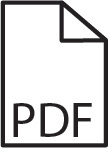 Volltext als PDF
(
GröÃe:
9.0 MB
)
Volltext als PDF
(
GröÃe:
9.0 MB
)
Lizenz ¶
Jedermann darf dieses Werk unter den Bedingungen der Digital Peer Publishing Lizenz elektronisch überÂmitteln und zum Download bereitÂstellen. Der Lizenztext ist im Internet unter der Adresse http://www.dipp.nrw.de/lizenzen/dppl/dppl/DPPL_v2_de_06-2004.html abrufbar.
Empfohlene Zitierweise ¶
Paul Meurs, Marie-Thérèse van Thoor: "The transformation of the Rijksmuseum Amsterdam". In archimaera#006 (2015). (urn:nbn:de:0009-21-42544)
Bitte geben Sie beim Zitieren dieses Artikels die exakte URL und das Datum Ihres letzten Besuchs bei dieser Online-Adresse an.
